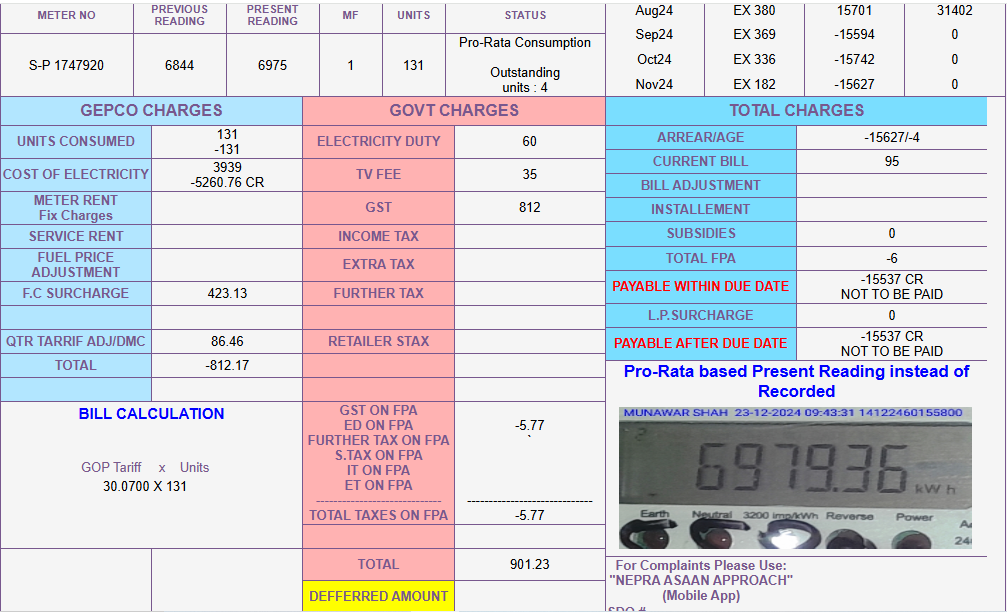Electricity bills in Pakistan can often seem complex, with various charges, tariffs, and taxes making it difficult to understand the final amount. However, calculating your electricity bill doesn’t have to be a daunting task.
This article provides a step-by-step guide on how to calculate electricity bills in Pakistan, including the formulas, tariff rates, and tools you can use. Whether you’re a residential or commercial consumer, this guide will help you understand your electricity bill and manage your energy expenses effectively.

Table of Contents
Understanding the Components of an Electricity Bill
Before diving into calculations, it’s essential to understand the key components of an electricity bill in Pakistan:
- Energy Consumption (kWh): The total units of electricity consumed during the billing period.
- Tariff Rates: The cost per unit of electricity, which varies depending on the consumer category (residential, commercial, industrial).
- Fixed Charges: A fixed monthly fee regardless of energy consumption.
- Taxes and Duties: Includes GST (General Sales Tax), TV license fee, and other government levies.
- Fuel Price Adjustment (FPA): An additional charge based on fluctuations in fuel prices.
- Electricity Duty: A provincial tax applied to the total bill.
Step-by-Step Guide to Calculate Your Electricity Bill
Here’s a detailed breakdown of how to calculate your electricity bill in Pakistan:
Step 1: Determine Your Energy Consumption
- Check your electricity meter to find the current reading.
- Subtract the previous reading from the current reading to determine the total units consumed (kWh).
Step 2: Identify Your Tariff Category
- Residential, commercial, and industrial consumers have different tariff rates.
- Refer to the latest tariff schedule provided by your distribution company (e.g., GEPCO, LESCO, IESCO).
Step 3: Apply the Tariff Rates
- Multiply the total units consumed by the applicable tariff rate.
- For residential consumers, tariff rates are often slab-based, meaning the rate increases with higher consumption.
Step 4: Add Fixed Charges
- Add the fixed monthly charges applicable to your tariff category.
Step 5: Calculate Taxes and Duties
- Apply GST (currently 17% in Pakistan) to the total amount.
- Add other charges like the TV license fee and electricity duty.
Step 6: Include Fuel Price Adjustment (FPA)
- Check the FPA rate for the billing period (available on your distribution company’s website).
- Multiply the total units consumed by the FPA rate and add it to the bill.
Step 7: Sum Up All Charges
- Add the energy charges, fixed charges, taxes, and FPA to get the total bill amount.

Example Calculation
Let’s assume a residential consumer has consumed 300 kWh in a month. Here’s how the bill is calculated:
- Energy Consumption: 300 kWh
- Tariff Rates (Residential):
- First 100 kWh: Rs. 10/unit
- Next 200 kWh: Rs. 15/unit
- Fixed Charges: Rs. 200
- GST: 17%
- FPA: Rs. 2/unit
Calculations:
- Energy Charges: (100 x 10) + (200 x 15) = Rs. 1,000 + Rs. 3,000 = Rs. 4,000
- Fixed Charges: Rs. 200
- Subtotal: Rs. 4,000 + Rs. 200 = Rs. 4,200
- FPA: 300 x 2 = Rs. 600
- Total Before Tax: Rs. 4,200 + Rs. 600 = Rs. 4,800
- GST: 17% of Rs. 4,800 = Rs. 816
- Total Bill: Rs. 4,800 + Rs. 816 = Rs. 5,616
Tools to Simplify Bill Calculation
To make the process easier, you can use the following tools:
- Online Bill Calculators:
- Most distribution companies (e.g., GEPCO, LESCO) offer online bill calculators on their websites.
- Input your consumer number and energy usage to get an instant estimate.
- Mobile Apps:
- Some companies provide mobile apps for bill calculations and payments.
- Excel Templates:
- Create a custom Excel sheet with formulas to automate calculations.
Electricity Tariff Rates in Pakistan (2023)
Here’s a simplified table of residential tariff rates for reference:
| Consumption Slab (kWh) | Tariff Rate (Rs./kWh) |
|---|---|
| 1-100 | 10 |
| 101-200 | 15 |
| 201-300 | 20 |
| 301-700 | 25 |
| Above 700 | 30 |
Note: Rates may vary slightly depending on the distribution company.
Tips for Reducing Your Electricity Bill
Here are some practical tips to lower your electricity costs:
- Switch to LED Bulbs: They consume less energy and last longer.
- Use Energy-Efficient Appliances: Look for devices with high energy star ratings.
- Unplug Devices: Even in standby mode, devices consume power.
- Optimize Air Conditioner Usage: Set the temperature to 24-26°C for optimal efficiency.
- Regular Maintenance: Clean fans, ACs, and other appliances to ensure they work efficiently.
Challenges in Calculating Electricity Bills
While calculating electricity bills is straightforward, some challenges include:
- Complex Tariff Structures: Slab-based rates can be confusing.
- Frequent Changes in FPA: FPA rates change monthly, making calculations dynamic.
- Meter Reading Errors: Inaccurate meter readings can lead to incorrect bills.

Conclusion
Calculating your electricity bill in Pakistan may seem complicated at first, but with a clear understanding of the components and steps involved, it becomes much simpler. By following this guide, you can accurately estimate your electricity expenses, manage your energy consumption, and even reduce your bills. Whether you use manual calculations or online tools, staying informed about your electricity usage is key to effective financial planning.
Take control of your electricity bills today by applying these tips and tools. For more information, visit your distribution company’s website or contact their customer service.
Frequently Asked Questions (FAQs)
1. How is electricity consumption measured in Pakistan?
Electricity consumption is measured in kilowatt-hours (kWh) using an electricity meter.
2. What are fixed charges in an electricity bill?
Fixed charges are a monthly fee that consumers pay regardless of their energy usage.
3. How is GST calculated on electricity bills?
GST is calculated as 17% of the total bill amount (including energy charges, fixed charges, and FPA).
4. What is Fuel Price Adjustment (FPA)?
FPA is an additional charge based on fluctuations in fuel prices used for electricity generation.
5. Can I calculate my bill without a calculator?
Yes, you can manually calculate your bill using the steps outlined in this guide.
6. Are tariff rates the same for all distribution companies?
No, tariff rates may vary slightly between companies like GEPCO, LESCO, and IESCO.
7. How can I reduce my electricity bill?
Use energy-efficient appliances.
Turn off unused lights and devices.
Monitor your energy consumption regularly.
